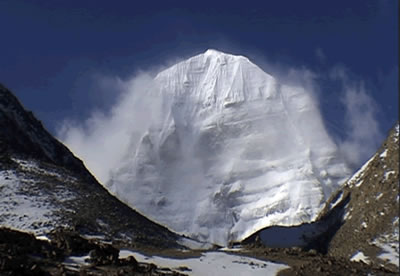 Mount Kailash in Tibet is his most recent subject which he visited in early spring 2006 after a journey from Kathmandu into Tibet and across the frozen wastelands beyond the Western Himalayas. A unique mountain, Kailash is worshipped by Hindus, Jain and Buddhists alike as the home of their Gods yet is so remote and difficult to get to that it is visited by only a handful of pilgrims each year. Strikingly beautiful, it has dominated the Indian imagination for millennia and is central to their world of myth, literature, architecture, sculpture, music and dance. It is not only a real mountain but also a conceptual mountain.
Mount Kailash in Tibet is his most recent subject which he visited in early spring 2006 after a journey from Kathmandu into Tibet and across the frozen wastelands beyond the Western Himalayas. A unique mountain, Kailash is worshipped by Hindus, Jain and Buddhists alike as the home of their Gods yet is so remote and difficult to get to that it is visited by only a handful of pilgrims each year. Strikingly beautiful, it has dominated the Indian imagination for millennia and is central to their world of myth, literature, architecture, sculpture, music and dance. It is not only a real mountain but also a conceptual mountain.
Climbing on Kailash is forbidden, so Cooper followed the centuries old pilgrim’s trail and circumambulated the Mountain, observing and recording his experiences as he went. Painting plein air and taking copious photographs, he started the process of engagement with the mountain and its ethos that continued back in his studio where the imaginative weight of the subject has revealed itself on large semi-abstract canvases that explore the links between myth, religion and sacredness on one hand and the pure geological and physical reality on the other.
Shunning a simple reliance on reproducing the appearance of things, Cooper’s expeditions and working method are his way of probing away at the deeper metaphorical significance of mountains and concerns which have been central to painting over the last hundred years or so. Whether the forgotten quarries of the Lake District or the sacred mountain of Tibet, the result is an unmistakably contemporary language for painting mountains.
Julian Cooper’s work is held in private and public collections worldwide. He has exhibited regularly in London and abroad; during 2005 he had a major retrospective at Museo Nazionale della Montagna in Turin, Italy, and his work was included in Tate Britain’s ‘A Picture of Britain’ exhibition.
There is a 30 page catalogue available with 15 colour plates and an edited conversation with Hamish Fulton.